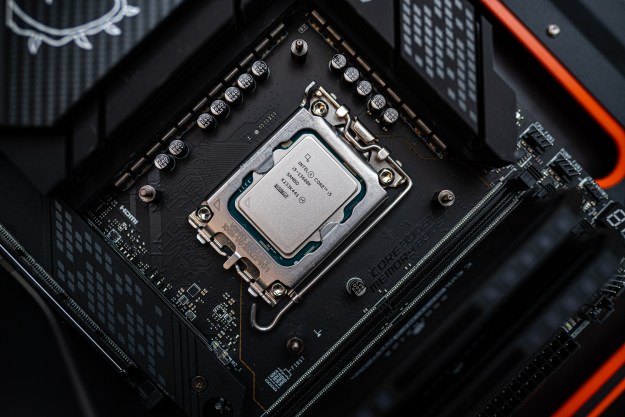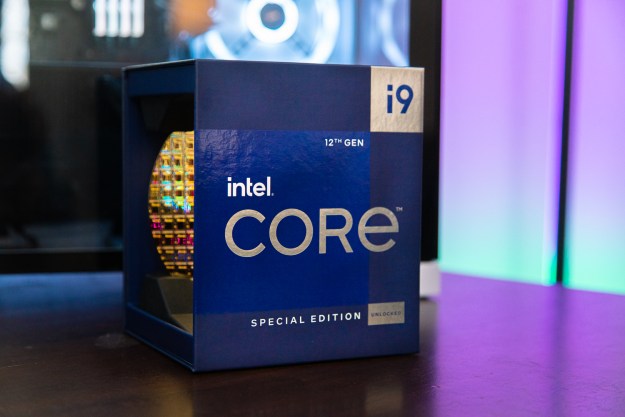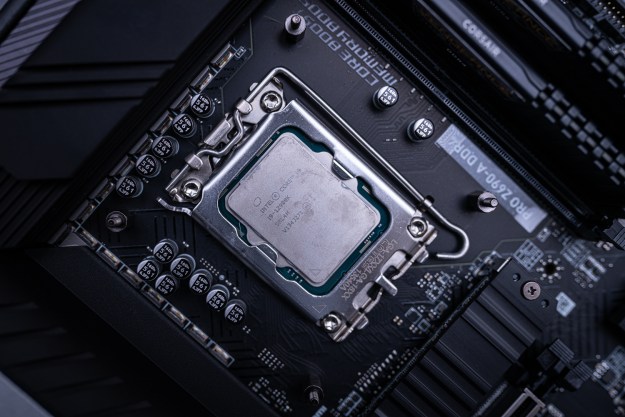
“The Intel Core i9-12900K undercuts the competition on price and overdelivers on performance.”
- Outpaces the Ryzen 9 5950X in most workloads
- Significantly cheaper than the Ryzen 9 5950X
- DDR5 support
- Solid overclocking headroom
- PCIe 5.0 on supported motherboards
- High power demands
- Runs a little hot
“Intel is back.” It’s a phrase you’ve heard muttered ad nauseam if you’ve been paying attention to CPUs over the past few years, even well before Intel fell behind AMD. It was only when AMD started to take over the desktop market with the launch of Ryzen 5000 that Intel started to put those words into action — and the result is Alder Lake.
The Core i9-12900K is Intel’s flagship Alder Lake chip, and after thoroughly testing it, it has earned a spot on our list of the best processors you can buy. It represents not only a new processor generation, but also the first release under a new CEO, the first time Intel has used its 10nm manufacturing process on desktop, and the first time we’ve seen a hybrid CPU architecture in a slot-in processor.
It also represents a company that has rested on its laurels for long enough to lose its thunder. AMD has surpassed Intel in the desktop and server market, and Apple ditched its longtime partnership with Intel to design its own chips that are faster and more efficient. Alder Lake, however, shows that Intel is indeed back.
Specs: What makes Alder Lake different
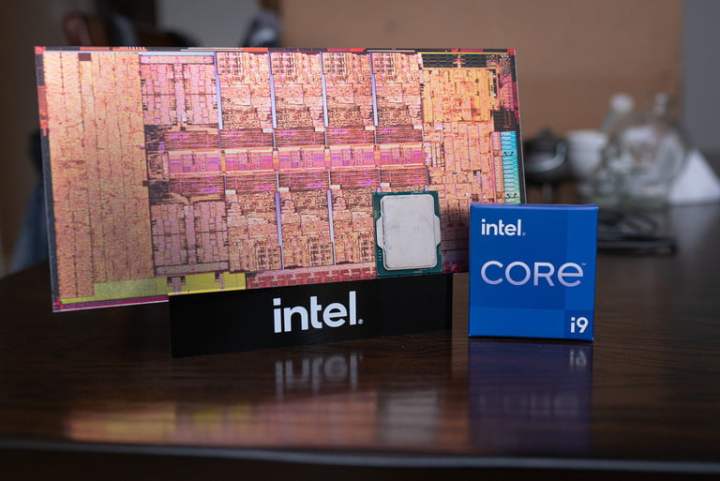
The Core i9-12900K is the flagship Alder Lake chip, sitting above the Core i5 and Core i7 models. There are two variations available, both of which are unlocked for overclocking.
The KF-series chip lacks integrated graphics, but it’s slightly cheaper, too. In terms of performance, the two chips are identical.
| Cores | Base frequency | Max boost frequency | Intel Smart Cache (L3) | Integrated graphics | Base power | Max turbo power | Suggested price | |
| Core i9-12900K | 16 (8P + 8E) | 3.2GHz (P-core), 2.4GHz (E-core) | Up to 5.2GHz | 30MB | Intel UHD 770 | 125W | 241W | $589 |
| Core i9-12900KF | 16 (8P + 8E) | 3.2GHz (P-core), 2.4GHz (E-core) | Up to 5.2GHz | 30MB | N/A | 125W | 241W | $564 |
| Core i7-12700K | 12 (8P + 4E) | 3.6GHz (P-core), 2.7GHz (E-core | Up to 5.0GHz | 25MB | Intel UHD 770 | 125W | 190W | $409 |
| Core i7-12700KF | 12 (8P + 4E) | 3.6GHz (P-core), 2.7GHz (E-core) | Up to 5.0GHz | 25MB | N/A | 125W | 190W | $384 |
| Core i5-12600K | 10 (6P + 4E) | 3.7GHz (P-core), 2.8GHz (E-core) | Up to 4.9GHz | 20MB | Intel UHD 770 | 125W | 150W | $289 |
| Core i5-12600KF | 10 (6P + 4E) | 3.7GHz (P-core), 2.8GHz (E-core) | Up to 4.9GHz | 20MB | N/A | 125W | 150W | $264 |
Comparing the specs to AMD does effectively nothing. Not only are AMD and Intel using different architectures, but AMD’s most recent chips don’t use a hybrid architecture like Intel’s do. Both the Core i9-12900K and AMD’s Ryzen 9 5950X are 16-core processors, but those cores couldn’t be more different.
That’s because the Core i9-12900K uses two types of cores. Instead of 16 big cores, it uses eight performant (P) cores and eight efficient (E) cores. The P-cores handle the big, important tasks, while the E-cores clean up everything in the background. The Core i9-12900K is technically a 16-core processor, but only eight of those cores are comparable to AMD.
The two specs I can compare are price and power. For power, the Intel chip draws a lot more — up to 241 watts at max turbo. The 5950X has a rated wattage of only 105W, though it can draw closer to 200W when overclocked. Still, that’s well below the Core i9-12900K. The 5950X only requires a single 8-pin CPU connector, while the Core i9-12900K requires two.
Power draw is higher on the Core i9-12900K, but the price is lower. At the suggested price, the Core i9-12900K is $210 cheaper than the 5950X, though prices are closer at most retailers. The Core i9-12900K actually sells for closer to $650, while the Ryzen 9 5950X is around $750. Still, a $100 price difference is a significant gap.
Test configurations
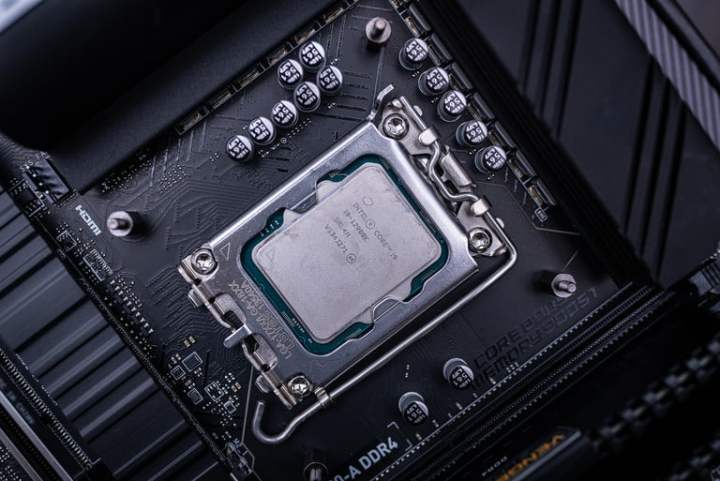
Before getting into the results, here are the four rigs I used for testing:
| Alder Lake DDR5 | Alder Lake DDR4 | AMD Zen 3 | Intel 10th-gen | |
| CPU | Intel Core i9-12900K | Intel Core i9-12900K | AMD Ryzen 9 5950X | Intel Core i9-10900K |
| GPU | Nvidia RTX 3090 Founders Edition | Nvidia RTX 3090 Founders Edition | Nvidia RTX 3090 Founders Edition | Nvidia RTX 3090 Founders Edition |
| RAM | 32GB SK Hynix DDR5-4800 | 32GB Corsair Vengeance LPX DDR4-3200 | 32GB Corsair Vengeance LPX DDR4-3200 | 32GB Corsair Vengeance LPX DDR4-3200 |
| Motherboard | MSI Z690 Carbon Wi-Fi | MSI Pro Z690-A DDR4 | Gigabyte Aorus B550 Elite | Asus Tuf Gaming Z490-Plus |
| CPU cooler | Corsair H115i Elite Capellix | Corsair H115i Elite Capellix | Corsair H115i Elite Capellix | Corsair H115i Elite Capellix |
| Power supply | bequiet! 850W 80 Plus Platinum | bequiet! 850W 80 Plus Platinum | bequiet! 850W 80 Plus Platinum | EVGA G6 1000W 80 Plus Gold |
| Storage | Corsair MP400 1TB SSD | Corsair MP400 1TB SSD | Corsair MP400 1TB SSD | Crucial MX500 2TB SSD |
For my main CPU and gaming tests, I ran the Alder Lake bench with DDR5. DDR5 is an advantage of the platform, after all, so it should sit alongside the processor to show what Alder Lake and Z690 are capable of. Similarly, I ran my tests on the latest build of Windows 11, making sure to download the patches for the recent bugs caused by AMD chips.
Naturally, DDR5 and Windows 11 paint Alder Lake in the most positive light. Still, I went back and retested DDR4 and Windows 10 to spot the differences, and although there are some clear disparities, they don’t apply across workloads.
Performance
Intel promised a massive leap forward with Alder Lake, and based on my results, the Core i9-12900K delivers. Throughout my tests, one thing became clear: Intel is able to deliver the same 16-core performance as the AMD Ryzen 9 5950X, not only at a lower price, but also with half of its cores running at full power.
| Intel Core i9-12900K | AMD Ryzen 9 5950X | Intel Core i9-10900K | |
| Cinebench R23 single-core | 1,989 | 1,531 | 1,291 |
| Cinebench R23 multi-core | 27,344 | 27,328 | 13,614 |
| Geekbench 5 single-core | 2,036 | 1,726 | 1,362 |
| Geekbench 5 multi-core | 18,259 | 14,239 | 10,715 |
| PC Mark 10 | 9,092 | 8,254 | 7,593 |
| Handbrake (seconds, lower is better) | 47 | 58 | 72 |
| Pugetbench for Premiere Pro | 1,066 | 992 | 855 |
| Pugetbench for Photoshop | 1,315 | 1,009 | 1,023 |
| 7-Zip | 126,215 | 139,074 | 86,172 |
Cinebench R23 perfectly illustrates that. This demanding benchmark tasks the CPU with rendering an image, so it’s a great way to isolate the processor from other components. When all the cores are working, the Core i9-12900K and Ryzen 9 5950X produce almost identical results.
That doesn’t look great, but it’s important to keep Alder Lake’s hybrid architecture in mind — and the fact that it’s $200 less than the Ryzen 9 5950X. The single-core score makes the disparity clear, where the Core i9-12900K is nearly 30% faster. Over the Core i9-10900K, the new chip is almost 62% faster in the single-core Cinebench R23 test.
The Core i9-12900K competes with the Ryzen 9 5900X on price and the 5950X on performance.
Geekbench 5 is a little tighter, with the Core i9-12900K outpacing the AMD chip by around 28% in the multi-core test. That’s a massive improvement, but it’s almost solely on the back of DDR5. With DDR4, the Core i9-12900K is actually slower than the Ryzen 9 5950X in the multi-core test, though it maintains a lead in the single-core test.
PC Mark 10 provides a good look at how these chips stack up overall, though. There, the Core i9-12900K is about 10% faster than the Ryzen 9 5950X and about 20% faster than the 10th-gen chip.
In creative apps, both Intel chips hold the lead. Although the Core i9-10900K scored below the Ryzen 9 5950X in the Premiere Pro benchmark, it shouldn’t be nearly as close as it is. The biggest difference comes from Photoshop, where the Core i9-12900K enjoys a 30% lead over the Ryzen 9 5950X — likely on the back of DDR5.

Out of the seven benchmarks I ran, the Ryzen 9 5950X only took first place in one: 7-Zip. In this test, the Ryzen 9 5950X is about 10% faster than the Core i9-12900K. This result explains the tighter Geekbench results, as Geekbench takes into account file compression and decompression.
Intel delivered. The Core i9-12900K competes with the Ryzen 9 5900X on price, but competes with the Ryzen 9 5950X on performance — and is coming out with a significant lead at that.
Gaming
Intel has touted the Core i9-12900K as the best gaming CPU on the market, and my results back that up. It shows some clear advantages over the Core i9-10900K while mostly matching the Ryzen 9 5950X. Still, there are a couple of issues with Alder Lake and particular games.
All of the tests below were run at 1080p with High to Ultra graphics presets. I ran tests at 1440p and 4K as well, though there isn’t much to report. The differences are consistent across resolutions, and at 4K where games become bound by the GPU, the three chips show no difference in performance.
| Intel Core i9-12900K | AMD Ryzen 9 5950X | Intel Core i9-10900K | |
| 3D Mark Time Spy | 19396 | 17922 | 18341 |
| Red Dead Redemption 2 | 137 fps | 135 fps | 129 fps |
| Assassin’s Creed Valhalla | 118 fps | 121 fps | 122 fps |
| Forza Horizon 4 | 234 fps | 201 fps | 200 fps |
| Civilization VI (turn time, lower is better) | 7.3 seconds | 7.5 seconds | 6.5 seconds |
Assassin’s Creed Valhalla is the best place to start, as it’s one example of a game that struggles with Alder Lake. It trails both the Ryzen 9 5950X and Core i9-10900K. Worse than that, I couldn’t get the benchmark to work consistently. The game would crash immediately, causing hours of headaches as I troubleshooted a problem with no clear answer.
Ubisoft and Intel confirmed that Valhalla has some issue with the Core i9-12900K, though wouldn’t provide more details beyond that. Regardless, when the game worked, it performed slightly below the Ryzen 9 5950X and the Core i9-10900K. I didn’t encounter issues with other games, suggesting that this issue is on Ubisoft’s end.
3D Mark shows clearer scaling between the three chips, with the Ryzen 9 5950X and Core i9-10900K in a tight grouping while the Core i9-12900K shoots ahead. The final score is about 8% faster than the Ryzen 9 5950X, likely aided by the improved bandwidth of DDR5. As I’ll get into in the next section, DDR5 showed a clear benefit in this benchmark.
For the first time in a while, Intel is showing a clear lead in gaming.
My Ryzen 5950X result was almost identical to the one I got with the same chip inside the Origin Neuron. That said, the average result from the 3D Mark leaderboards is slightly higher. This is likely a memory issue; even with XMP enabled, the Ryzen 9 5950X produced subpar results. You’d need to tighten timings to achieve a higher score, which is a problem the Core i9-12900K doesn’t have.
Forza Horizon 4 produced the largest difference in raw frame rate, with the Core i9-12900K showing a 16% lead over the other two chips. Forza also provides frame rates specifically from the CPU, and the Core i9-12900K has some big advantages. At 1080p, it outpaced the Ryzen 9 5950X by 21% in the CPU render frame rate and 10% in CPU simulation.
This game also showed a difference at 1440p, with Core i9-12900K maintaining a solid 22 fps lead over the other two chips. Although some games won’t benefit much from Alder Lake — take my Red Dead Redemption 2 results as an example — others will, with big gains.
For the first time in a while, Intel is showing a clear lead in gaming. The Core i9-12900K may be overkill for most games — it’s still bound by the GPU at 4K, after all — but it still seems leaps beyond last-gen parts and the competition.
DDR4 vs. DDR5

I ran my main tests with DDR5. There’s no way around it: DDR5 offers advantages over DDR4. There isn’t a world where I could compare the Core i9-12900K to the Ryzen 9 5950X without handicapping Intel’s more recent release.
DDR5 is an advantage of Alder Lake, so it’s as relevant to performance as the processor itself. Still, I retested a limited suite of benchmarks with DDR4 to gauge how much of a difference you can expect with the new memory standard.
| DDR4 | DDR5 | |
| PC Mark 10 | 8794 | 9092 |
| 3D Mark Time Spy (overall) | 18175 | 19396 |
| Red Dead Redemption 2 (1080p Ultra) | 114 fps | 115 fps |
| Geekbench 5 single-core | 1902 | 2036 |
| Geekbench 5 multi-core | 12969 | 18259 |
| Pugetbench for Premiere Pro | 1019 | 1066 |
Overall, the differences are minor — outside of an oddly large gap in my multi-core Geekbench 5 results. For gaming, DDR5 didn’t make any difference in Red Dead Redemption 2, and in 3D Mark Time Spy, it represented just shy of a 7% increase. That’s nothing to sneeze at, but take into account variations between runs, and the difference doesn’t look that large.
Similarly, PC Mark 10 showed only a 3% increase with DDR5, and PugetBench for Premiere Pro showed virtually no difference at all. The oddball is Geekbench’s multi-core test, which showed nearly a 41% increase with DDR5. This illustrates the main performance point with DDR5: it really depends on the application.
DDR5 has a lot more bandwidth, but that comes at the cost of latency. Clearly, modern applications favor bandwidth more, but some do much more so than others. Overall, you’re looking at a slight bump with DDR5, with some applications taking particularly well to the new memory standard.
I want to use this section to clear up some confusion, though. Although Alder Lake supports DDR4 and DDR5, they aren’t interchangeable. You can’t slot a DDR4 stick into a DDR5 motherboard, or vice versa. Make sure to pay attention to what type of memory your Z690 motherboard supports before picking it up.
Windows 11 vs. Windows 10

Alder Lake not only represents the launch of DDR5, but also the launch of Windows 11. AMD chips have some issues with the new operating system, so I ran the same suite of limited tests on the Core i9-12900K and Ryzen 9 5950X across Windows 11 and Windows 10 to see the differences. There’s not a lot to report.
| Intel Core i9-12900K Windows 11 | Intel Core i9-12900K Windows 10 | |
| PC Mark 10 | 9092 | 7919 |
| 3D Mark Time Spy | 19396 | 19511 |
| Red Dead Redemption 2 | 115 fps | 112 fps |
| Geekbench 5 single-core | 2036 | 1962 |
| Geekbench 5 multi-core | 18259 | 18282 |
| Pugetbench for Premiere Pro | 1066 | 1283 |
For the Core i9-12900K, the differences are negligible for the most part. The most significant increase came from PC Mark 10, where my Windows 11 rig was nearly 15% faster. That’s on the back of a high Creation score in PC Mark 10, which Alder Lake seems particularly well-suited for.
Premiere Pro showed a big difference, too: About a 20% increase in favor of Windows 10. I used an older version of Premiere for my tests, though — v15.4, in case you were wondering — which may not have the same optimizations for Windows 11.
| AMD Ryzen 9 5950X Windows 11 | AMD Ryzen 9 5950X Windows 10 | |
| PC Mark 10 | 8254 | 8041 |
| 3D Mark Time Spy | 17922 | 17572 |
| Red Dead Redemption 2 | 135 fps | 133 fps |
| Geekbench 5 single-core | 1726 | 1710 |
| Geekbench 5 multi-core | 14239 | 14084 |
| Pugetbench for Premiere Pro | 992 | 994 |
There wasn’t a difference with the Ryzen 9 5950X, either. Although 3D Mark Time Spy and Red Dead Redemption 2 showed some minor changes, neither of them are consequential. It’s true that AMD chips had issues with Windows 11 before, but the most recent Windows and AMD updates seemed to have solve them — at least in the tests I ran.
Overclocking, clock speeds, and thermals
The Core i9-12900K boasts a single-core boost of 5.2GHz, which I hit time and again during testing. All-core frequencies are naturally lower. In a 30-minute AIDA64 stress test, the chip managed an all-core frequency of 4.8GHz, reaching a peak of 84 degrees Celsius while drawing 210W of power.
84 degrees is hot, but the Core i9-12900K didn’t stay there long. AIDA64 is a stress test, too, and this is still 16 degrees below the maximum operating temperature of 100 degrees. Under a moderate load, the chip mostly stayed around 50 to 60 degrees Celsius, only climbing higher when all cores were pushed to the limit.
Performant as it is, the Core i9-12900K has high power demands.
I briefly dug into Intel’s Extreme Tuning Utility (XTU) to get an moderate overclock working. Using Speed Booster, I was able to boost the frequency to 5GHz by pressing a single button. Originally, this produced a much higher temperature, but after reseating my cooler, everything ran smoothly.
Alder Lake chips are rectangular, so the tried and true pea method of applying thermal paste didn’t cover the chip. I spread out the paste just a little bit — not to the edges — while reseating to cover it completely. Temperatures returned to normal.
Although the Speed Booster gives you an overclock without any of the work, you can achieve higher clock speeds by tweaking the cores manually. I applied a 300MHz boost to all cores with Intel’s Thermal Velocity Boost turned on, and I was able to hit 5.4GHz while consuming 300W of power. That’s a lot. Performant as it is, the Core i9-12900K follows in the footsteps of previous Intel generations with high power demands.
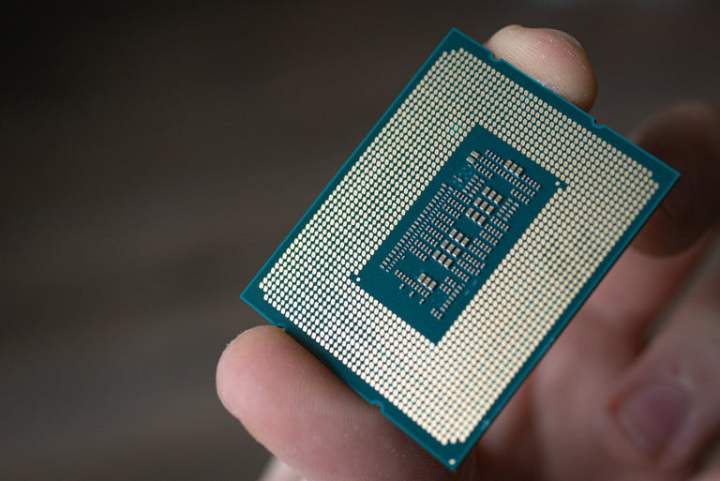
Although there’s still a lot to explore with how the P-core and E-core react to overclocking, I noticed a few general trends while testing. Boosting the E-core frequency didn’t impact power draw, thermals, or performance much. The difference is workload specific, so overclocking your E-cores will do nothing for applications that primarily use the P-cores. On the flip side, the P-cores made up the bulk of power and thermal increases while overclocking, so it’s best to be conservative with your P-core overclocks.
Our take
The Core i9-12900K represents a lot of things for Intel, but more than anything, it represents a company that’s ready to get competitive again. Even at its worst, the Core i9-12900K matches the Ryzen 9 5950X — and for a significantly lower price. At its best, it blows past both the best AMD has to offer and everything else on the market.
Power is a concern, as it has been for the past several Intel generations. High power demands are much easier to swallow when there’s extra performance on the table, though, and that’s what the Core i9-12900K offers.
Are there any alternatives?
There isn’t anything like the Core i9-12900K on desktop right now. The closest competitor is the AMD Ryzen 9 5950X, though it’s not nearly as fast as the Core i9-12900K.
How long will it last?
The Core i9-12900K will last for the next several years at least. If you’re buying a processor as high-end as the Core i9-12900K, you’ll likely upgrade before performance becomes a major issue.
Should you buy it?
Yes. Right now, there isn’t anything that performs as well as the Core i9-12900K. That said, it consumes a lot of power, so make sure to buy a beefy power supply and cooler alongside it.
Editors' Recommendations
- Gamers are reportedly returning Intel Core i9 CPUs in droves
- Intel’s Core Ultra CPUs are more Apple, less AMD
- AMD Ryzen 9 7950X3D vs. Intel Core i9-13900K: only one choice for PC gamers
- Intel’s 24-core laptop CPU might outclass desktop i9 processors
- Intel Core i9-13900K vs. Core i9-12900K: Is it worth the upgrade?


